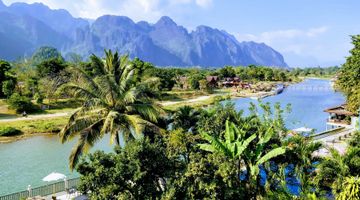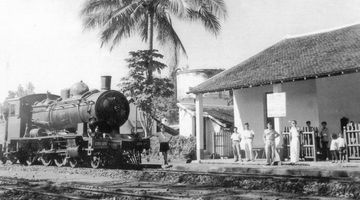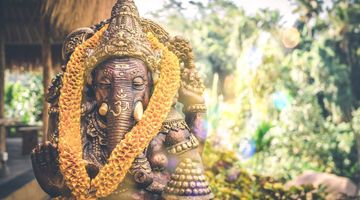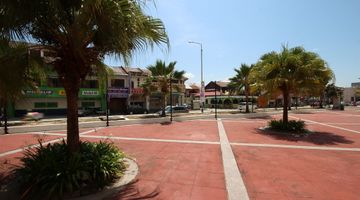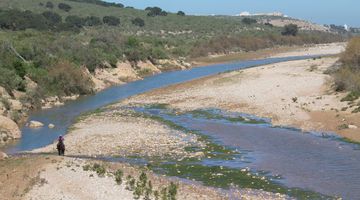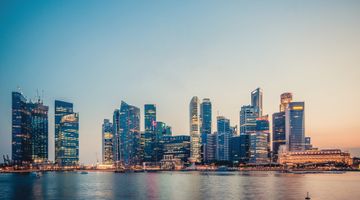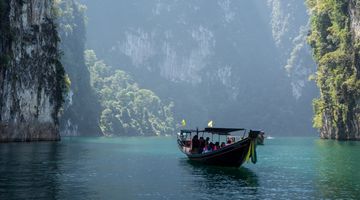Where to travel in Laos: 12Go’s Travel Guide
They say the Vietnamese plant rice, the Khmer watch it grow, and the Lao listen to it grow. That’s probably all you need to know about the pace of life in Laos - well, and the attitude to work there.
Although landlocked, Laos revolves around water, with the Mekong River at its center. The river feeds rice fields, supports vital fish habitats, and acts as a key transport route, shaping life in the country.
Why should you visit Laos?
Laos remains a mainly off-the-beaten-path destination even if Vientiane is well-explored by Thai ex-pats - it is the favorite destination for visa runs for those who live in Pattaya, Bangkok, and further north.
That does not necessarily mean that there is nothing to see and do in Laos — on the contrary, it is one of few Southeast Asian countries where the commercialization of tourism has not yet taken over.
Laos does not boast beautiful beaches and warm seas, the main draws for many Southeast Asian travelers. However, it has an abundance of stunning natural sights and quite impressive colonial heritage, which blends weirdly with traditional Lao culture to create a one-of-a-kind architectural mix. Laos is also quite a safe destination with friendly locals, though the level of healthcare—should you need any medical help—can be pretty low.
While Vientiane, Luang Prabang, and Vang Vieng may be on some traveler’s must-visit lists, you can discover much more if you cast a broader glance at what the country offers.
There are impressive Khmer ruins to explore – you will be surprised to discover a temple complex of this scale outside Cambodia; there are underground rivers to navigate – and you will be shocked to find out there is a whole village that can be reached only via a 7km boat ride in complete darkness; then there are those famous and mysterious jars – you can spend days, weeks and months trying to uncover the truth behind their creation.
Ask your fellow travelers what of the above they have seen and visited—and buy your tickets to Laos immediately! Before you go, check the visa requirements for your passport.
When to visit Laos?
Enjoying a tropical monsoon climate, Laos is usually hot to scorching all year round except in the elevated areas like Plateau Bolaven. While there is a rainy season from May to October, it is not a problem if you are not going too deep into the wild – access to some conservation areas can be restricted then.
That said, the rainy season in Laos is usually drier than the similar season in Thailand, and your risk of being stuck in a hotel or a guesthouse room for the whole day is shallow. Bolaven Plateau is wet year-round, and Luang Prabang is the wettest place in Laos.
It is a heaven for all souls outdoorsy. Oh yes, that’s entirely right! Tubing is the first thing that comes to everyone’s mind – and it still goes strong in Vang Vieng.
Caving is another one. The best thing about caving in Laos is that there are so many untouched caves to explore - in the sense that there are no walkways, lights, or big buses bringing hordes of tourists - as is the case with many other similar places in the region. You cannot stop thanking the Gods that Laos has not started promoting itself as a prime tourist destination.
The karst formations around Vang Vieng, in the north and to the east, all along the border with Thailand, are unique. They also offer some excellent opportunities for climbing—think Vang Vieng and further north again.
There are some worth-visiting National biodiversity conservation areas in Laos offering great trekking trails of different levels of difficulty – from Dong Amphan in the east along the border with Vietnam to Don Hua Sao in Bolaven Plateau to barely accessible Hin Namno in the center and many more.
How to get to Laos?
By plane
✈️ Laos has three international airports - Vientiane, Luang Prabang, and Pakse. Direct flights are available from Bangkok, Hanoi, Kuala Lumpur, and Singapore. Flights from Bangkok or Kuala Lumpur to Vientiane cost around LAK350,000.
By land
Numerous border crossings connect Laos with Thailand, Cambodia, Vietnam, and China. Visa on arrival is available at most crossings, though processing times can vary, and some bus companies may not wait for those without pre-approved visas.
Budget for Traveling in Laos
Traveling in Laos can be affordable without too much effort. However, both accommodation and food options are slightly more expensive compared to what you can see in Thailand. Yet you are likely to be able to score a perfect double room with an en-suite bathroom, air conditioning, and Wi-Fi for about LAK100,000 almost everywhere in the country.
Street food and cheapies are ubiquitous. A bowl of rice is accessible wherever you are heading and should cost around LAK10,000.
🚍 Buses and vans are the primary means of transport connecting different destinations around the country. Refrain from finding luxury VIP liners; you will have air conditioning on longer routes. However, get prepared for bumpy rides and winding roads.
Bigger buses are also usually affordable and link the most significant cities within Laos with destinations in Thailand, Vietnam, Cambodia, and China.
That said, low-cost airlines have yet to make their way to Laos, and the national flag carrier, Lao Airlines, is, in most cases, the only choice if you wish to fly. It is far from cheap—expect to pay between 1500 and 2000 USD one-way, and unless budget is not an issue, look for ground transportation options.
Another issue you may find annoying in Laos is the local habit of imposing ‘a fee’ on foreigners for almost everything: Do you need to cross that 1m wide stream? There is a shaky bridge; just pay LAK5,000.
See that local who walks by your side while you are heading to explore the cave all by yourself? Be sure he will ask you for a tip of some USD10 up afterward – even if you have not asked him to accompany you. It is inevitable, so come prepared and do not let these trifles spoil your Lao trip.
Where to travel in Laos?
Most of those who visit Lao almost inevitably start with Vientiane, the capital city. The next major star destination is Luang Prabang, and many tourists just make a quick beeline there to take a flight. Those who travel overland usually check Vang Vieng en route. And that’s probably all! Only a thin flow of backpackers and adventure seekers venture out to explore further south to Pakse and Champasak or go to the wild, wild north – to Bokeo and beyond to get in touch with the most remote – and beautiful! – parts of the country.
Vientiane
Yes, we know that Thai expats—many Laos expats—do not like Vientiane. Indeed, dusty and spread out, the city lacks the charm of colonial Savannakhet and cannot offer the natural wonders of smaller destinations like Vang Vieng.
But Vientiane is proliferating today with modern shopping centers and high-rise condominiums changing the skyline and lifestyle of the city, and the sunsets over the Mekong River are always spectacular.
Ancient wats in Vientiane are stunning, and the restaurant scene won’t disappoint. Besides, Vientiane can offer the best transportation solutions wherever you are heading next in Laos.
Where to go from Vientiane?
Vientiane to Hanoi Vientiane to Hanoi connects two capitals, offering seamless travel and a gateway to Hanoi’s rich history and nearby attractions like Halong Bay.
Vientiane to Vang Vieng is a quick escape into Laos' adventure capital, offering stunning karst landscapes and river activities.
Vientiane to Luang Prabang connects you to Laos' cultural heart, known for its stunning temples, waterfalls, and UNESCO World Heritage charm.
Vientiane to Pakse offers a journey to southern Laos, home to the serene 4,000 Islands, Bolaven Plateau, and rich Mekong culture.
Luang Prabang
Full of French colonial fleur ‘shaken, not stirred’ with traditional Lao architecture, Luang Prabang is unique.
Elegant yet very cozy, often topping the ‘travelers' choice’ lists of various paper and online magazines and awards, Luang Prabang offers colorful glimpses of the times when Laos was a part of French Indochine.
Though it is easily reached via direct flights from regional capitals and some of the bigger cities like Kuala Lumpur, Singapore, Siem Reap, or Hanoi, the most authentic way to get to Luang Prabang is probably by a slow boat from Houay Xai – well, if you are patient enough!
Where to go from Luang Prabang?
Luang Prabang to Vientiane Traveling from Luang Prabang to Vientiane lets you explore Laos' capital, contrasting heritage temples with modern cafes and Mekong River views.
Luang Prabang to Vang Vieng offers a scenic journey to Laos' adventure hub, where stunning landscapes and outdoor activities like tubing and trekking await.
Luang Prabang to Hanoi connects two historic cities, offering a mix of Laos' tranquil charm and Vietnam's culture. It is also easily accessible to iconic sights like Halong Bay.
Luang Prabang to Chiang Mai provides a seamless route between two cultural gems, blending Laos' serene heritage and Chiang Mai’s rich history, temples, and nearby mountain landscapes.
Vang Vieng
Once the country's open-air party capital, with a free flow of alcohol and weed in every bar you could make a stop at while tubing, Vang Vieng has been working on its image lately and got a lot quieter in the best sense of the word after these venues were banned.
Yet tubing, excellent caving, hot air ballooning, and stunning scenery are all there, plus a couple of music festivals have recently visited Vang Vieng, adding to the appeal.
Where to go from Vang Vieng?
Vang Vieng to Luang Prabang offers a scenic journey from Laos’ adventure hub to its cultural heart, where tranquil temples and natural beauty await.
Vang Vieng to Vientiane offers a journey from Laos' adventure hotspot to its amazing capital, where you can explore temples, enjoy riverside views, and experience the local culture.
Vang Vieng to Hanoi connects Laos' adventure scene with Vietnam's capital, offering a mix of natural beauty and rich cultural experiences.
Vang Vieng to Phonsavan takes you from Laos' adventure hub to the historic Plain of Jars, where you can explore ancient stone jar sites and learn about the region's fascinating history.
Pakse
Located in southern Laos, Pakse is a peaceful town with much to offer those looking to explore off the beaten path. The ancient Wat Phou temple, a UNESCO World Heritage site, is just one of its historical highlights.
The surrounding Bolaven Plateau, with its waterfalls and coffee farms, is perfect for nature lovers. The Mekong River provides a tranquil backdrop for boat trips to the nearby 4,000 Islands. With its relaxed vibe and authentic local culture, Pakse is ideal for travelers seeking a quieter, more genuine experience in Laos.
Where to go from Pakse?
Pakse to Siem Reap connects southern Laos with Cambodia’s cultural heart, offering easy access to the iconic Angkor temples and a rich blend of history and heritage.
Pakse to Ubon Ratchathani offers a convenient route from southern Laos to northeastern Thailand, where you can explore temples, local markets, and the unique cultural blend of the Isaan region.
Pakse to Bangkok connects southern Laos with Thailand's bustling capital, offering cultural experiences, shopping, nightlife, and easy access to nearby historical and natural attractions.
Pakse to Luang Prabang takes you from the scenic south to Laos' cultural heart, allowing you to explore ancient temples, waterfalls, and the city's UNESCO-listed charm.
Pakse to Savannakhet offers a journey through southern Laos, where you can explore the region's historical sites, quiet riverside towns, and the cultural blend of Lao and Thai influences.
Nong Khiaw
Nong Khiaw, a quiet town in northern Laos, is a real gem for those looking to connect with nature. It's surrounded by stunning limestone mountains and lush greenery, making it perfect for hiking and exploring.
You can visit nearby caves and waterfalls and enjoy breathtaking views from the viewpoints. A boat trip along the Nam Ou River also offers a chance to experience the tranquil village life. If you're looking for a peaceful, off-the-beaten-path spot to relax and soak in the natural beauty of Laos, Nong Khiaw is the place to be.
Where to go from Nong Khiaw?
Nong Khiaw to Luang Prabang offers a scenic route through Laos' stunning landscapes, from peaceful riverside views to the cultural and historical richness of Luang Prabang's temples and UNESCO World Heritage charm.
Nong Khiaw to Vang Vieng takes you from Laos' tranquil riverside village to an adventure hub, where you can enjoy outdoor activities amid stunning karst mountains and explore the local scene.
Nong Khiaw to Luang Namtha offers a scenic journey through northern Laos, leading to the region’s rich ethnic diversity, lush landscapes, and trekking and eco-tourism opportunities.
Nong Khiaw to Muang Khua takes you through northern Laos' picturesque landscapes, offering a more remote and peaceful destination known for its rugged beauty and traditional village culture.
Nong Khiaw to Hanoi connects northern Laos with Vietnam's capital. It offers a scenic journey through mountainous landscapes before reaching Hanoi's rich history, bustling streets, and cultural landmarks.
Where to go in Laos if you like
Ancient ruins
Ancient Khmer Angkor-style ruins in Laos? No problem, lads! Listed on the UNESCO World Heritage Sites, Wat Phu dates back to the 12th century and is located near the tiny provincial capital of Champasak in Southern Laos. Considerably more diminutive than Cambodia's world-famous temple complex, Wat Phu is somewhat homier. With jungle-covered green cloudy hills in the background, elaborate stone carvings on lintels, and exquisite blind windows contrast dilapidating buildings.
The enigmatic stone jars in Phonsavan are not exactly ruins but a unique sight. Get there and guess who, when, and why created these mysterious giant structures. Extraterrestrial aliens? Epic heroes? Or Mother Nature?
Nature and trekking
We cannot just have enough of Northern Laos – and if you are adventurous, fit, and constantly searching for less traveled roads, you’ll understand us! Taking a cult slow boat from Houay Xai to Luang Prabang, ziplining by day, listening to the voices of jungles by night and searching for the endangered gibbons in Bokeo Nature Reserve, or meditating amid the stunning scenery of the sleepy riverside village of Muang Ngoi Neua – the Northern Laos remains one of the most enchanting destinations in the whole SEA.
Colonial architecture
Luang Prabang is a must-see, but take advantage of Savannakhet, too. A quieter and more provincial experience, Savannakhet is full of charm. The historical quarter surrounds a quaint St. Teresa’s Church and gets alive every evening when a street food market takes over the church square.
Two-wheeled road trips
The most popular and well-known route for the two-wheeled road trips in Laos is called – without too much imagination – The Loop. Starting from Thakhek in Central Laos, it heads northwest to Veing Kham via Ban Hinboon via Route 13, then turns east over Route 8 to Ban Na Hin with an essential detour to the Konglor Cave featuring an underground river to finally reach Route 12, which branches south and brings you back to the starting point in Thakhek. This over-400-km journey is one of the most scenic routes in the region.
How to Get Around Laos?
By Train
Buying train tickets locally can be challenging, but online booking offers convenience. Getting around Laos by train is a scenic and relaxed way to travel, though the rail network is still developing.
The most popular route connects Vientiane to Luang Prabang, offering travelers a comfortable ride with beautiful countryside views. Another option is the China-Laos railway, which runs from Vientiane to Boten near the Chinese border, opening up more possibilities for northern travel.
Trains in Laos are relatively modern and offer a slower, yet more scenic, alternative to bus travel. Although the rail system is expanding, it’s becoming an increasingly attractive option for those exploring the country.
By Plane ✈️
Domestic flights in Laos offer a quick and convenient way to travel between critical cities like Vientiane, Luang Prabang, and Pakse. These flights operate daily, allowing travelers to explore multiple destinations quickly.
One-way fares typically start around LAK600,000, though prices may vary depending on the season and booking time. Flying is instrumental if you want to save time and avoid long road journeys, especially when heading to more remote areas. Despite the limited number of airports, domestic flights provide a comfortable option for those looking to cover more ground in Laos.
By Bus
Buses are a popular and affordable way to get around Laos, though they can be essential. Regular buses are budget-friendly, offering a no-frills way to travel between cities and towns. VIP buses provide air conditioning and slightly better seating for more comfort, making longer journeys more pleasant.
Minivans are also an option. They offer faster travel times but less space, making them suitable for shorter trips or those who are okay with tighter seating. While buses are an economical choice, they can sometimes be slower due to road conditions, so it's essential to plan accordingly.
By Boat
Traveling by boat along the Mekong River is a scenic and popular way to explore Laos. Slow ships, which offer a more relaxed journey, are commonly used for longer routes like the trip from Hua Xai to Luang Prabang, taking in breathtaking views of the river and surrounding landscapes.
Speedboats provide quicker options for those in a hurry, though they can be less comfortable and more thrilling. River travel offers a unique perspective of the country, especially in remote areas, and remains a favorite for tourists looking to experience traditional transport while enjoying the beauty of Laos.
Visa Requirements to Laos
Visa requirements for Laos depend on your nationality, but most travelers will need a tourist visa. You can obtain a visa through an embassy or by applying for a visa on arrival at certain airports and border crossings, with a typical validity of 30 days, extendable for another 30 days.
Alternatively, travelers from eligible countries can apply for an e-visa online, which is valid for entry at specific checkpoints like Vientiane, Luang Prabang, and Pakse. Some nationalities, such as those from Thailand, Vietnam, and Malaysia, are exempt from needing a visa for short stays, usually up to 30 days. Checking the specific visa requirements based on your nationality before your trip is essential.
Perfect Laos Itinerary
Day 1-3: Vientiane
Start your journey in Vientiane, the capital. Visit the iconic Pha That Luang stupa, explore the Patuxai monument, and discover the Talat Sao morning market. Take a peaceful stroll along the Mekong River at sunset and enjoy local delicacies like leaps (Lao salad) and sticky rice.
Day 4-5: Vang Vieng
Head to Vang Vien, a small town surrounded by towering limestone mountains and clear rivers. Go tubing, kayaking, or hike to viewpoints for stunning panoramic views. Explore the caves and lagoons, such as Tham Chang Cave or Blue Lagoon.
Day 6-7: Luang Prabang
Travel to Luang Prabang, a UNESCO World Heritage site. Visit Wat Xieng Thong and Kuang Si Falls and participate in the morning alms-giving ceremony for monks. Then, enjoy a boat ride on the Mekong River to see the Pak Ou Caves, filled with thousands of Buddha statues.
Day 8-9: Nong Khiaw
Head to Nong Khiaw for peace and adventure—Trek through the jungle to discover caves, waterfalls, and scenic viewpoints. Take a boat trip along the Nam Ou River to explore remote villages and experience the untouched beauty of northern Laos.
Day 10: Pakse and Bolaven Plateau
Finish your trip with a visit to Pakse in the south. Explore the Bolaven Plateau with its coffee plantations, waterfalls, and villages. Visit Tad Fane Waterfall and enjoy the relaxed vibe of Pakse before heading home.
What to eat in Laos?
Khao Piak Chewy rice noodles in starchy soup. You could top it with meat. It comes with a serving of raw vegetables and herbs, shrimp, peanut concoction dipping sauce, and lime. Chewy rice noodles are a phenomenon like pho, and they can only be found in Laos, at least in my travels.
Khao Soi is a soupy rice noodle delight served with fermented soybean paste and crushed tomatoes. It might be a little spicy.
Pho is similar to Vietnamese pho. Noodle soup—rice noodles or yellow noodles—is usually served with different meaty toppings, such as a small plate of bean sprouts and lime. It is similar to the noodle soup I have in Singapore.
Lao coffee – and baguettes! – are arguably the best ones in the whole region
We are serious. We must thank the French for the baguettes and the cool climate of Bolaven.
Plateau for coffee.
While the central part of coffee grown in Laos is robusta, the brew is always very energizing, with gentle yet full-bodied aroma and subtle ‘green’ notes of organic beans. It is easy to get your perfect cup of Lao coffee in Vientiane, Luang Prabang, Vang Vieng, or Savannakhet; try it as if you are going into the wild; things are not as easy there.
FAQ
1. Is it worth going to Luang Namtha?
Luang Namtha is ideal for nature lovers, those seeking authentic cultural experiences, and those trekking in the stunning Nam Ha National Protected Area. Adventure activities like kayaking and cycling are also available in a quiet, less-touristed setting.
2. Is it safe to go to Laos?
Laos is generally safe for travelers, though some rural areas may still have unexploded landmines. To ensure a safe trip, stick to famous places, secure your valuables, and stay cautious on the roads.
3. What is Laos best known for?
Laos is most known for its stunning landscapes, ancient temples, and the UNESCO World Heritage city of Luang Prabang. It’s also famous for its relaxed pace, Mekong River cruises, and rich Buddhist culture.
